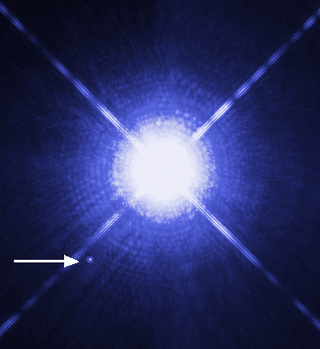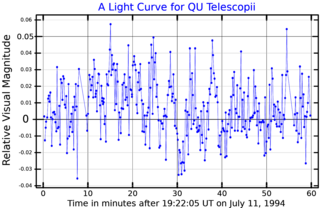Related Research Articles

A white dwarf is a stellar core remnant composed mostly of electron-degenerate matter. A white dwarf is very dense: its mass is comparable to the Sun's, while its volume is comparable to Earth's. A white dwarf's low luminosity comes from the emission of residual thermal energy; no fusion takes place in a white dwarf. The nearest known white dwarf is Sirius B, at 8.6 light years, the smaller component of the Sirius binary star. There are currently thought to be eight white dwarfs among the hundred star systems nearest the Sun. The unusual faintness of white dwarfs was first recognized in 1910. The name white dwarf was coined by Willem Jacob Luyten in 1922.

HL Tau 76 is a variable white dwarf star of the DAV type. It was observed by G. Haro and W. J. Luyten in 1961, and was the first variable white dwarf discovered when, in 1968, Arlo U. Landolt found that it varied in brightness with a period of approximately 749.5 seconds, or 12.5 minutes. Like other DAV white dwarfs, its variability arises from non-radial gravity wave pulsations within itself., § 7. Later observation and analysis has found HL Tau 76 to pulsate in over 40 independent vibrational modes, with periods between 380 seconds and 1390 seconds.

HD 27245, also known as HR 1335 or rarely 25 H. Camelopardalis is a solitary red-hued star located in the northern circumpolar constellation Camelopardalis. It has an apparent magnitude of 5.4, making it faintly visible to the naked eye. Gaia DR3 Parallax measurements place it approximately 607 light years away from it the Solar System and is drifting further away with a heliocentric radial velocity of 25.2 km/s. At its current distance, HD 27245's brightness is diminished by 0.36 magnitudes due to extinction from interstellar dust. It has an absolute magnitude of −0.27.

RX Andromedae is a variable star in the constellation of Andromeda. Although it is classified as a dwarf nova of the Z Camelopardalis (UGZ) type, it has shown low-luminosity periods typical of VY Sculptoris stars. However, for most of the time it varies from an apparent visual magnitude of 15.1 at minimum brightness to a magnitude of 10.2 at maximum brightness, with a period of approximately 13 days.
Kelu-1 is a system of two brown dwarfs of spectral types L2 and L4 located in constellation Hydra at approximately 60.6 light-years from Earth. It is among the first free-floating later-than-M-type brown dwarfs discovered, and sometimes considered as prototype of L-type brown dwarfs.

EC 20058-5234 , is a star in the constellation Telescopium. With an apparent magnitude of 15.03, it's impossible to detect with the naked eye and requires a powerful telescope to be seen; this degenerate object is located 388 light years from the Solar System based on parallax.

S Apodis, also known as HD 133444 is a variable star located in the southern circumpolar constellation Apus. It has an apparent magnitude ranging from 9.6 to 17, which is below the limit for naked eye visibility. The object is located relatively far at a distance of approximately 15,000 light years based on Gaia DR3 parallax measurements, but it is drifting closer with a heliocentric radial velocity of −75 km/s.
Gliese 318 is a white dwarf in the constellation Pyxis. Its spectral type is DA5.5 and it has a visual magnitude of 11.85, and lies 27.8 light-years away. The star was too faint to have had its parallax measured by the Hipparcos satellite. Earth-based measurement in 2009 gave its parallax as 113.63 ± 1.97 milliarcseconds, yielding a distance of 28.7 ± 0.5 light-years; this parallax measurement has since been substantially improved by Gaia. It is around 45% as massive as the Sun but has only 0.15% its luminosity.
Ross 640 is a white dwarf star in the northern constellation of Hercules, positioned near the constellation border with Corona Borealis. With an apparent visual magnitude of 13.83, it is too faint to be visible to the naked eye. Its trigonometric parallax from the Gaia mission is 62.9″, corresponding to a distance of 52 light-years.
WD J2356−209 is a white dwarf star located 65 pc away from the Earth. It is a very faint white dwarf, with an apparent visual magnitude of 21.03. Its visible spectrum is dominated by a broad absorption feature that has been attributed to pressure-broadened sodium D lines. The presence of this sodium absorption feature and the detection of spectral lines from other heavy elements indicate that the photosphere of WD J2356−209 has been polluted by a recent rocky debris accretion episode. A detailed analysis of the spectrum of WD J2356−209 shows that the accreted planetesimal was abnormally sodium-rich, containing up to ten times more sodium than calcium. With an effective temperature of 4040 K, WD J2356−209 was the coolest metal-polluted white dwarf observed at the time.

14 Trianguli, also known as HD 15656, is a spectroscopic binary located in the northern constellation Triangulum. It has an apparent magnitude of 5.14, making it faintly visible to the naked eye in ideal conditions. Gaia DR3 parallax measurements place the system 433 light years away, and it is currently approaching the Solar System with a heliocentric radial velocity of −37 km/s. At its current distance, 14 Tri's brightness is diminished by 0.21 magnitude due to interstellar dust. It has an absolute magnitude of −0.46.

HD 23005, also known as HR 1124, is a solitary, yellowish-white hued star located in the northern circumpolar constellation Camelopardalis, the giraffe. It has an apparent magnitude of 5.78, making it faintly visible to the naked eye. The object is located relatively close at a distance of 173 light years based on Gaia DR3 parallax measurements but is receding with a heliocentric radial velocity of 4.9 km/s. At its current distance, HD 23005's brightness is diminished by 0.15 magnitudes due to extinction from interstellar dust. It has an absolute magnitude of +2.07.

WD 1425+540 (G200-39) is a white dwarf that accreted an exocomet. This is evident from the pollution of the white dwarf atmosphere with metals, especially the pollution with nitrogen. WD 1425+540 is the first white dwarf with detected nitrogen. The white dwarf has a K-dwarf companion called G200-40, about 40 arcseconds away. The white dwarf nature of the object was discovered by Greenstein in 1974.

GALEX J2339–0424 is a white dwarf that is suspected to be polluted with material originating from an icy exomoon. This is evident from the first detection of beryllium in this white dwarf, together with GD 378.

WD 2317+1830 is one of the first white dwarfs with lithium detected in its atmosphere. The white dwarf is surrounded by a debris disk and is actively accreting material. Researchers suggest that the presence of alkali metals indicates the accretion of crust material. Another work however cautions to use alkali metals as a single indicator of crust material. They suggest that such objects could be polluted by mantle material instead.

WD J2147–4035 is a very cold white dwarf with a temperature of about 3,050 Kelvin. It also shows signs of pollution with planetary debris.
References
- 1 2 3 "Ruiz 439-26". SIMBAD . Centre de données astronomiques de Strasbourg . Retrieved October 22, 2020.
- 1 2 3 4 5 María Teresa Ruiz; P. Bergeron; S. K. Leggett; Claudio Anguita (1995). "The Extremely Low Luminosity White Dwarf ESO 439-26". The Astrophysical Journal. 455. Bibcode:1995ApJ...455L.159R. doi: 10.1086/309845 . S2CID 120193018.
- 1 2 3 4 Bergeron, P.; Leggett, S. K.; Ruiz, María Teresa (April 2001). "Photometric and Spectroscopic Analysis of Cool White Dwarfs with Trigonometric Parallax Measurements". Astrophysical Journal Supplement Series. 133 (2): 413–449. arXiv: astro-ph/0011286 . Bibcode:2001ApJS..133..413B. doi: 10.1086/320356 . S2CID 15511301.
- 1 2 3 4 5 Vallenari, A.; et al. (Gaia collaboration) (2023). "Gaia Data Release 3. Summary of the content and survey properties". Astronomy and Astrophysics. 674: A1. arXiv: 2208.00211 . Bibcode:2023A&A...674A...1G. doi: 10.1051/0004-6361/202243940 . S2CID 244398875. Gaia DR3 record for this source at VizieR.
- 1 2 3 4 Gentile Fusillo, N. P.; Tremblay, P. -E.; Cukanovaite, E.; Vorontseva, A.; Lallement, R.; Hollands, M.; Gänsicke, B. T.; Burdge, K. B.; McCleery, J.; Jordan, S. (2021-12-01). "A catalogue of white dwarfs in Gaia EDR3". Monthly Notices of the Royal Astronomical Society. 508 (3): 3877–3896. arXiv: 2106.07669 . Bibcode:2021MNRAS.508.3877G. doi: 10.1093/mnras/stab2672 . ISSN 0035-8711.
- ↑ Ruiz, Maria Teresa; Bergeron, P.; Leggett, S. K.; Anguita, Claudio (1995-12-01). "The Extremely Low Luminosity White Dwarf ESO 439-26". The Astrophysical Journal. 455: L159. doi: 10.1086/309845 . ISSN 0004-637X.
- ↑ "The Faintest Known White Dwarf". www.noao.edu. 1 March 1996. Archived from the original on 12 March 2021. Retrieved 8 May 2020.
- ↑ Kaler, James B. (May 7, 2006). The Hundred Greatest Stars. Springer Science & Business Media. ISBN 9780387216256 – via Google Books.
- ↑ Elms, Abbigail K.; Tremblay, Pier-Emmanuel; Gänsicke, Boris T.; Koester, Detlev; Hollands, Mark A.; Gentile Fusillo, Nicola Pietro; Cunningham, Tim; Apps, Kevin (2022-12-01). "Spectral analysis of ultra-cool white dwarfs polluted by planetary debris". Monthly Notices of the Royal Astronomical Society. 517 (3): 4557–4574. arXiv: 2206.05258 . Bibcode:2022MNRAS.517.4557E. doi: 10.1093/mnras/stac2908 . ISSN 0035-8711.